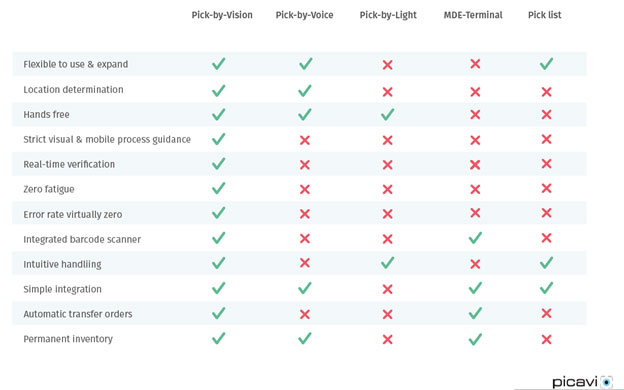Pick-by-vision systems support lean manufacturing initiatives. Reducing human error in production and assembly defines error-proofing.
By Thomas R. Cutler
Pick-by-vision systems support lean manufacturing initiatives. By reducing the risk of human error in production and assembly processes, pick-by-vision is an ideal solution for poka-yoke (error-proofing).
Pick-by-vision devices visually guide operators to pick the correct parts, in the right quantities, and proper sequence. This reduces errors and defects while increasing productivity by eliminating a common source of wasted time like checking and re-checking instructions.

© 2021 Picavi
Manual assembly often requires multiple parts and steps to complete, and at each step, there is a risk of human error. An incorrect part may be picked from a part bin, or parts may be incorrectly put together. Accuracy is critical to ensure a high-quality final product.
Manufacturers need assemblies completed quickly to maximize throughput.
The challenge is to increase assembly speeds while maintaining quality.
To improve efficiency and accuracy in assembly applications, it is essential for the assembler to identify the next pick location quickly and easily. Pick-by-vision glasses guide the worker to the correct bin for verification. Only when verified as an accurate pick can the worker move on.
Vision picking is easy to integrate in any warehouse because it establishes a lean solution that is connected directly with the existing ERP or WMS, without the need for middleware, a dedicated server or hosting. The pre-assembled communication modules create an interface between the head-mounted display and the software environment. Using this software environment allow warehouse and distribution center managers to request pick lists that have been created to suit the process and optimize routes. Importantly vision picking provides feedback on the processing status. Depending on the system architecture, the bidirectional communication runs via web services such as SOAP or REST, FTP batches or XML.
Two companies using pick-by-vision include Neovia Logistics in Indianapolis, Indiana. The simplified guidance for users reduced 60% of training time and helped overall outbound order accuracy. Similarly, at DB Schenker the company achieved improved operational efficiency gains.
Errors are common when parts are manually assembled, especially when there is a demand for a variety of different parts. Similar components and hard-to-follow instructions lead to human error during production, which slows down the entire process and introduces defects.
Using pick-by-vision at multi-product assembly stations lessens the number of inaccuracies, speeds up build-time, and makes training simple.
Takt time is important to manufacturers because it represents the rate of production needed to match demand. Keeping production rates by the estimated takt time is a simple way to maximize profits.
In addition to guiding picks, visual data can also be used to indicate takt time in assembly processes. This visual feedback can help keep an assembler on track and aware of how much time has elapsed without having to look away from work.
Reducing total order cycle time improves the customer experience while expanding profits by optimizing omni-channel fulfillment. It allows for later order cutoff times which increase volume while decreasing the amount of inventory on hand and helps with asset-to-cash conversion.
Pick-by-vision improves the efficiency of operations and effectively reduces total order cycle time. Pick-by-vision allows manufacturers and warehouse facility managers to avoid stock outs because these technologies automatically track inventory and provide notifications when a reorder is necessary—before running out a single SKU. Warehouse control systems (WCS) or warehouse management systems (WMS) prevent the loss of time and productivity that occurs if a forward picking location is empty before it can be restocked. They have configurable minimum and maximum inventory levels informing pick-by-vision labor; replenishments are automatically scheduled before the picking location is empty.

Thomas R. Cutler
Thomas R. Cutler is the President and CEO of Fort Lauderdale, Florida-based, TR Cutler, Inc., celebrating its 22nd year. Cutler is the founder of the Manufacturing Media Consortium including more than 8000 journalists, editors, and economists writing about trends in manufacturing, industry, material handling, and process improvement. Cutler authors more than 1000 feature articles annually regarding the manufacturing sector. More than 4800 industry leaders follow Cutler on Twitter daily at @ThomasRCutler. Contact Cutler at trcutler@trcutlerinc.com.
In this episode, I sat down with Beejan Giga, Director | Partner and Caleb Emerson, Senior Results Manager at Carpedia International. We discussed the insights behind their recent Industry Today article, “Thinking Three Moves Ahead” and together we explored how manufacturers can plan more strategically, align with their suppliers, and build the operational discipline needed to support intentional, sustainable growth. It was a conversation packed with practical perspectives on navigating a fast-changing industry landscape.